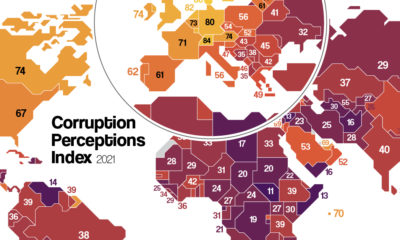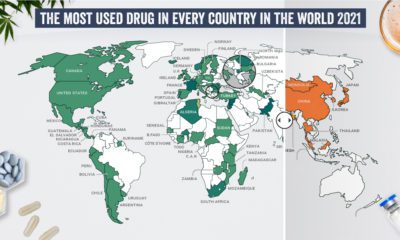But as an industry that has laid dormant for decades, it will need to shed its negative connotations that have limited its potential and undermined new discoveries for so long. The infographic above showcases data from The Report on Psychedelics which explains seven of the most common psychedelic substances and examines the many mind-bending ways they could radically transform mental health as we know it.
Resurrecting a Stigmatized Industry
Although evidence of humans using psychedelics as medicine dates back thousands of years, it was not until the 1940s that psychiatrists became advocates of their therapeutic potential. Unfortunately, recreational psychedelics became a symbol of the 1960’s counterculture movement, which contaminated the industry’s reputation. The U.S. responded by introducing the Controlled Substances Analogue Enforcement Act, deeming these drugs illegal and stymying research studies in the process. Following some new discoveries in the early ‘90s however, psychedelics moved from the hands of festival-goers back to the labs of scientists. Since then, certain substances such as psilocybin have been granted breakthrough therapy status for treating depression by the U.S. FDA. With these recent developments, new companies and investment opportunities are beginning to emerge in the psychedelics space. But these complex drugs are not always easy to understand—so let’s dive in.
What are Psychedelics?
Psychedelics are psychoactive substances that can alter perception, mood, and cognitive processes. There are two broad classifications of psychedelics that relate to chemical structure.
Entheogenic Plants: Plants or fungi that produce chemical substances that can cause hallucinations Synthetic Drugs: Drugs created in laboratory setting to mimic the effects of entheogenic plants
Here are seven of the most common psychedelic substances explained: To avoid history repeating itself, Johns Hopkins University has created the Center for Psychedelic and Consciousness Research with the aim of enforcing strict standards of scientific rigor for the industry to follow.
On the Precipice of Change
With sound scientific evidence and standards coming into place, it’s no surprise that investors—from bestselling author Tim Ferris to several established cannabis companies—are supporting the born-again industry. Given the industry’s foothold in recreational use, a therapeutic comeback may be a tough pill for many to swallow. However, it is possible that we are on the precipice of not only a psychedelic revolution but more importantly, a mental health one. —Stanislav Grof on Last year, stock and bond returns tumbled after the Federal Reserve hiked interest rates at the fastest speed in 40 years. It was the first time in decades that both asset classes posted negative annual investment returns in tandem. Over four decades, this has happened 2.4% of the time across any 12-month rolling period. To look at how various stock and bond asset allocations have performed over history—and their broader correlations—the above graphic charts their best, worst, and average returns, using data from Vanguard.
How Has Asset Allocation Impacted Returns?
Based on data between 1926 and 2019, the table below looks at the spectrum of market returns of different asset allocations:
We can see that a portfolio made entirely of stocks returned 10.3% on average, the highest across all asset allocations. Of course, this came with wider return variance, hitting an annual low of -43% and a high of 54%.
A traditional 60/40 portfolio—which has lost its luster in recent years as low interest rates have led to lower bond returns—saw an average historical return of 8.8%. As interest rates have climbed in recent years, this may widen its appeal once again as bond returns may rise.
Meanwhile, a 100% bond portfolio averaged 5.3% in annual returns over the period. Bonds typically serve as a hedge against portfolio losses thanks to their typically negative historical correlation to stocks.
A Closer Look at Historical Correlations
To understand how 2022 was an outlier in terms of asset correlations we can look at the graphic below:
The last time stocks and bonds moved together in a negative direction was in 1969. At the time, inflation was accelerating and the Fed was hiking interest rates to cool rising costs. In fact, historically, when inflation surges, stocks and bonds have often moved in similar directions. Underscoring this divergence is real interest rate volatility. When real interest rates are a driving force in the market, as we have seen in the last year, it hurts both stock and bond returns. This is because higher interest rates can reduce the future cash flows of these investments. Adding another layer is the level of risk appetite among investors. When the economic outlook is uncertain and interest rate volatility is high, investors are more likely to take risk off their portfolios and demand higher returns for taking on higher risk. This can push down equity and bond prices. On the other hand, if the economic outlook is positive, investors may be willing to take on more risk, in turn potentially boosting equity prices.
Current Investment Returns in Context
Today, financial markets are seeing sharp swings as the ripple effects of higher interest rates are sinking in. For investors, historical data provides insight on long-term asset allocation trends. Over the last century, cycles of high interest rates have come and gone. Both equity and bond investment returns have been resilient for investors who stay the course.













